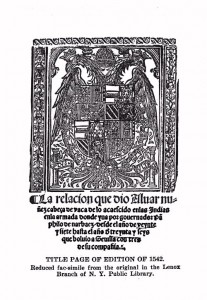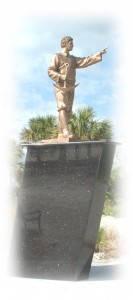In a month in which we have seen the brutal massacre of peaceful African Americans at prayer in Charleston, South Carolina, it is perhaps timely to tell the remarkable account of the first named Orthodox Christians in what would become the United States, together with their Black African companion. So let’s begin their story:
The year is 1527, a mere thirty-five years after Columbus’ “discovery” of the New World. It is only six years after Martin Luther’s expulsion from the Roman Catholic Church, seven years prior to Henry VIII’s separation of the Church of England from Rome, and nine years before John Calvin’s publication of his Institutes of the Christian Religion. So we are at the early dawn of the Protestant Reformation and well before the Roman Catholic Counter-Reformation, launched by the Council of Trent. (1545-1563) This means there are as yet no Eastern rite Catholics.
The place is San Lúcar de Barrameda on the south-west coast of Spain, some eighty miles to the west of your author’s birthplace of Gibraltar. The narrator (Álvar Núñez Cabeza de Vaca) tells us that:
On the seventeenth day of the month of June of 1527, Governor Pánfilo de Narváez departed from the port of San Lúcar de Barrameda by your majesty’s authority and orders, to conquer and govern the provinces which lie on the mainland from the River of Palms to Cape Florida.
The fleet of five ships and some six hundred men sailed first to Santa Domingo and then on to Cuba and Trinidad before finally sighting its intended destination of Florida on April 12, 1528. Shortly after, on Maundy Thursday of Holy Week by the Western Christian calendar, Native American villages were sighted. On Saturday, May 1, Narváez ordered his men to disembark and they set off on an increasingly dangerous journey inland, skirmishing with the local tribes and struggling to gain adequate food supplies. By the end of July a third of the men were sick and the decision was made to try to construct boats to enable them to return to the safety of Cuba. It is at this point that we are introduced to the man who was probably the first Orthodox Christian in the territory of what is now the United States:
The sole carpenter in our company had begun constructing the boats. We worked so diligently that we began on August 4th and had finished five boats by September 20th. Each one measured twenty-two cubits, and was caulked by palmetto fibers. We caulked them with a kind of pitch from resin, made by a Greek named Don Theodoro [emphasis mine] from some pine trees and palmetto fiber.
On September 22 almost 250 men set off in the five boats. A month later they had run out of fresh water and after five days of thirst began to drink salt water. It was clearly a desperate situation. Native people who had “many jugs of water and a large quantity of cooked fish” saved them. But something quickly went wrong and fighting broke out. The Spanish fled back to sea and were once again soon running out of water.
Three further days passed and they entered an estuary, most probably in the area of what is now Pensacola, Florida. The narrator continues:
Once in it [the estuary] we saw an Indian canoe coming. When we called them, they came to us, and the Governor, whose boat they reached, asked them for water. They offered to give us some if we gave them something in which to carry it. And a Greek Christian named Dorotheo Theodoro [emphasis mine], previously mentioned, said that he wanted to go with them. The Governor and others tried hard to stop him, but could not, since he insisted on going with them. He went and took with him a black man, and the Indians left hostages from their company. At night the Indians returned and brought our vessels without water; neither did they bring the Christians they had taken with them. When they spoke to the hostages they had left, the hostages attempted to jump into the water, but our men whose boat they were prevented them. So the Indians fled in their canoe and left us very sad and confounded at the loss of these two Christians.
When I first read this passage several years ago I interpreted it to mean that Theodoro and his African companion had offered themselves as hostages in return for water, to save the other members of their expedition. This would in effect be a kind of martyrdom: “Greater love hath no man than this, that a man lay down his life for his friend.” (John 15:13) Perhaps this was the case: it is interesting that the narrator calls both Theodoro and his African companion “Christians.” He normally reserves this term for Spaniards.
This past weekend I realized that this was not the end of the story of Theodoro and his companion. They did not die in 1528, but rather were still alive and living with the native peoples in 1540! Perhaps because they were not Spaniards, but cultural outsiders to the Narváez expedition, they increasingly sympathized with the natives in their encounters with the Spanish, and came to realize that their own chances for a better life lay with the indigenous peoples.
So how does their story continue? It is found in the writings of some of the members of the expedition of Hernando De Soto. These detail the journey made between 1539-1543 of what are believed to be the first Europeans to cross the Mississippi river. The account of Luys Hernandez de Biedma tells us that in 1540:
From here we went to the province of Coça…Here we had news of how the boats of Narvaez had arrived in need of water, and that here among the Indians remained a Christian who was called Don Teodoro and a black man with him. They showed us a dagger that the Christian had.
De Biedma’s account exists in both early Spanish and Portuguese manuscripts and the tenses are tricky. Another of these makes a crucial change in tense, as well as other details:
In 1540, when the soldiers under Soto came to the town of Mavila, they heard that Don Dorotheo, with his companions, had been there, and they were shown a dirk that had been his.
Note that this version also speaks of Theodoro having companions, not just one companion. The plot then thickens as another of De Soto’s men, Rodrigo Rangel, tells us of something else that happened when they arrived in Coça:
On Thursday they went to another small town and passed other towns, and on Friday the Governor entered in Coça. This is a great cacique with much land, and one of the best and most abundant [provinces] that they found in Florida…
On Friday, the twentieth of August, the Governor and his people left Coca and there remained behind a Christian who was named Feryada, A Levantine [emphasis mine]; and they spent the night beyond Talimuchusi.
So it seems there was also a Christian from the Eastern Mediterranean with De Soto’s expedition. The name would appear to be Turkish, suggesting he was perhaps from Anatolia. It is at least curious that he chose to remain behind in Coça, where Theodoro had recently lived. Perhaps more information about Feryada will come to light and reveal more of his story.
As to Theodoro and his black companion I have found two other secondary sources that suggest where they went from Florida. It would be better if primary sources could be found to confirm these.
The first states that they went to what is now south-west Alabama where Theodoro warned Tuscaloosa, the local native chief, not to trust De Soto and his fellow Spaniards with their overtures of friendship. The second comes from the pen of Thomas Buckingham Smith, an early nineteenth century Floridian historian, who privately published his own translation of Cabeza de Vaca’s narrative, in 1851. In a footnote Smith writes:
The Greek, having got thus far in safety, could have learned the difficulties of traversing the region of water and swamp on the other side of the great river in advance, and may have traveled inland. It is possible that, invited by the appearance of a country plentiful in subsistence, and of a less barbarous people, he may, we shall see hereafter, have taken “the road to the cattle,” and, getting far north, have passed his life among the hunters of the bison.
As with all historical research, we can only hope that more primary documents and archaeological evidence will come to light to flesh out such a fascinating story. But who would have thought it even possible that almost five hundred years ago, in what is now the United States, and as the Protestant Reformation was beginning in Europe, an Orthodox Christian/s and his/their black companion may have lived for several decades, traversing the country from Florida to the Great Plains, and living in harmony with the native peoples.
Nicholas Chapman Herkimer,New York June 22, 2015

